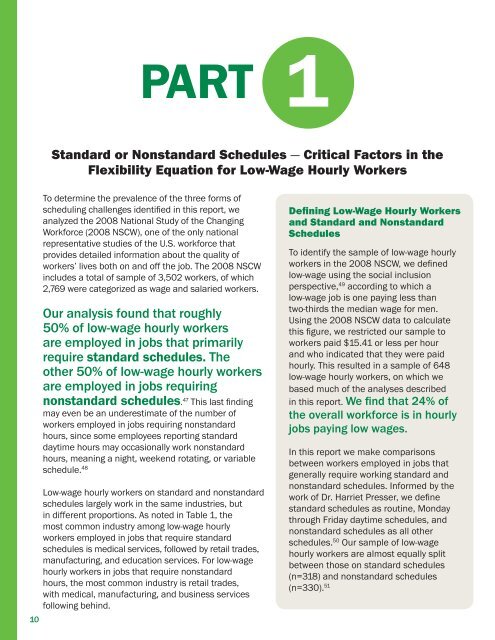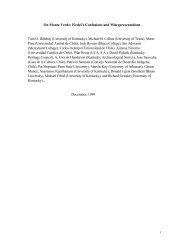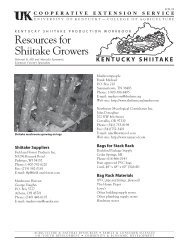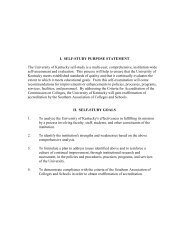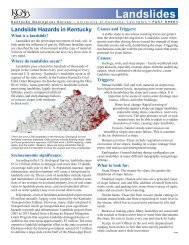Flexible Workplace Solutions for Low-Wage Hourly Workers
Flexible Workplace Solutions for Low-Wage Hourly Workers
Flexible Workplace Solutions for Low-Wage Hourly Workers
You also want an ePaper? Increase the reach of your titles
YUMPU automatically turns print PDFs into web optimized ePapers that Google loves.
PART 1<br />
Standard or Nonstandard Schedules — Critical Factors in the<br />
Flexibility Equation <strong>for</strong> <strong>Low</strong>-<strong>Wage</strong> <strong>Hourly</strong> <strong>Workers</strong><br />
10<br />
To determine the prevalence of the three <strong>for</strong>ms of<br />
scheduling challenges identifi ed in this report, we<br />
analyzed the 2008 National Study of the Changing<br />
Work<strong>for</strong>ce (2008 NSCW), one of the only national<br />
representative studies of the U.S. work<strong>for</strong>ce that<br />
provides detailed in<strong>for</strong>mation about the quality of<br />
workers’ lives both on and off the job. The 2008 NSCW<br />
includes a total of sample of 3,502 workers, of which<br />
2,769 were categorized as wage and salaried workers.<br />
Our analysis found that roughly<br />
50% of low-wage hourly workers<br />
are employed in jobs that primarily<br />
require standard schedules. The<br />
other 50% of low-wage hourly workers<br />
are employed in jobs requiring<br />
nonstandard schedules. 47 This last fi nding<br />
may even be an underestimate of the number of<br />
workers employed in jobs requiring nonstandard<br />
hours, since some employees reporting standard<br />
daytime hours may occasionally work nonstandard<br />
hours, meaning a night, weekend rotating, or variable<br />
schedule. 48<br />
<strong>Low</strong>-wage hourly workers on standard and nonstandard<br />
schedules largely work in the same industries, but<br />
in different proportions. As noted in Table 1, the<br />
most common industry among low-wage hourly<br />
workers employed in jobs that require standard<br />
schedules is medical services, followed by retail trades,<br />
manufacturing, and education services. For low-wage<br />
hourly workers in jobs that require nonstandard<br />
hours, the most common industry is retail trades,<br />
with medical, manufacturing, and business services<br />
following behind.<br />
Defining <strong>Low</strong>-<strong>Wage</strong> <strong>Hourly</strong> <strong>Workers</strong><br />
and Standard and Nonstandard<br />
Schedules<br />
To identify the sample of low-wage hourly<br />
workers in the 2008 NSCW, we defi ned<br />
low-wage using the social inclusion<br />
perspective, 49 according to which a<br />
low-wage job is one paying less than<br />
two-thirds the median wage <strong>for</strong> men.<br />
Using the 2008 NSCW data to calculate<br />
this fi gure, we restricted our sample to<br />
workers paid $15.41 or less per hour<br />
and who indicated that they were paid<br />
hourly. This resulted in a sample of 648<br />
low-wage hourly workers, on which we<br />
based much of the analyses described<br />
in this report. We find that 24% of<br />
the overall work<strong>for</strong>ce is in hourly<br />
jobs paying low wages.<br />
In this report we make comparisons<br />
between workers employed in jobs that<br />
generally require working standard and<br />
nonstandard schedules. In<strong>for</strong>med by the<br />
work of Dr. Harriet Presser, we defi ne<br />
standard schedules as routine, Monday<br />
through Friday daytime schedules, and<br />
nonstandard schedules as all other<br />
schedules. 50 Our sample of low-wage<br />
hourly workers are almost equally split<br />
between those on standard schedules<br />
(n=318) and nonstandard schedules<br />
(n=330). 51


